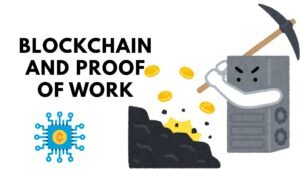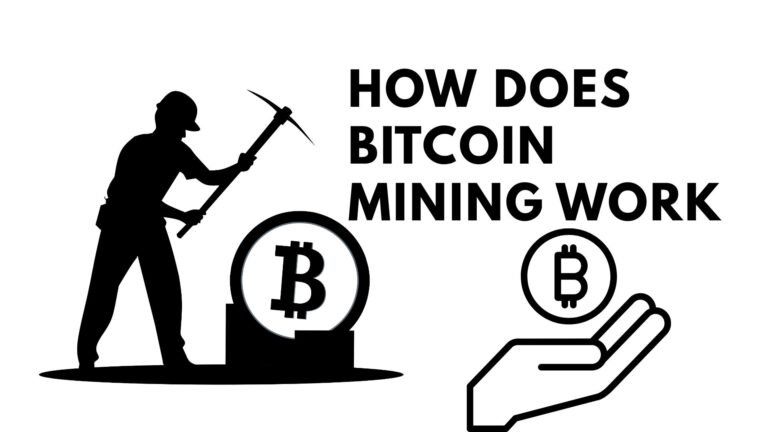How Does Bitcoin Mining Work? Learn what Bitcoin mining is, how it works, and what you need to start mining Bitcoin in 2025. Understand blockchain, mining rewards, profitability, and the future of Bitcoin mining.
1. What Is Bitcoin Mining?
Bitcoin mining is the process of creating new bitcoins and securing the Bitcoin network. It involves verifying transactions and adding them to the blockchain — a public digital ledger that records all Bitcoin activity.
Unlike traditional currencies controlled by banks or governments, Bitcoin is decentralized. Thousands of computers worldwide (called nodes) confirm transactions, making Bitcoin secure and transparent.
In short, Bitcoin mining does two main things:
- Creates new bitcoins.
- Confirms and secures transactions on the blockchain.
2. Understanding the Blockchain and Proof of Work.

Think of the blockchain as a digital notebook that stores every Bitcoin transaction ever made. Each page of this notebook is a “block,” and all pages together form the “chain.” To add a new block, miners must solve complex mathematical puzzles — a process known as Proof of Work (PoW).
The first miner to solve the problem gets to add the block to the chain and earn a Bitcoin reward. Proof of Work ensures fairness and prevents fraud or “double-spending.”
3. How Bitcoin Mining Works.
Bitcoin mining uses computers to solve cryptographic puzzles using the SHA-256 algorithm.
Here’s how it works in simple terms:
- A block collects recent Bitcoin transactions.
- Miners process this data through SHA-256 to create a unique code, called a hash.
- The goal is to find a hash that meets specific criteria (starts with a set number of zeros).
- Miners keep adjusting a number called a nonce until the correct hash is found.
- The first miner to find it wins the reward and adds the new block to the blockchain.
4. Bitcoin Mining Rewards and Halving.
Miners earn two types of rewards:
- New Bitcoins are created for each block mined.
- Transaction fees from users.
As of October 2025, the current block reward is 3.125 BTC.
This amount is reduced by half approximately every four years in an event called Bitcoin Halving.
Bitcoin Halving Timeline
| Year | Block Reward |
|---|---|
| 2009 | 50 BTC |
| 2012 | 25 BTC |
| 2016 | 12.5 BTC |
| 2020 | 6.25 BTC |
| 2024 | 3.125 BTC (current) |
This gradual reduction keeps Bitcoin scarce and can increase its value over time.
5. What You Need to Start Mining Bitcoin.
a. Mining Hardware
Today, mining requires specialized devices called ASICs (Application-Specific Integrated Circuits).
Popular models include Antminer and WhatsMiner, designed for maximum efficiency.
b. Mining Software
You’ll need software like CGMiner, BFGMiner, or EasyMiner to connect your hardware to the Bitcoin network.
c. Bitcoin Wallet
A Bitcoin wallet is essential for storing your mining rewards securely.
d. Mining Pool
Because solo mining is highly competitive, most miners join mining pools to combine their computing power and share rewards.
6. Costs Involved in Bitcoin Mining.
Mining can be expensive due to several key costs:
- Electricity: Mining machines consume large amounts of energy.
- Hardware: ASIC miners cost hundreds or even thousands of dollars.
- Cooling Systems: To prevent overheating.
- Maintenance: Ongoing repairs and upgrades are needed.
That’s why most large mining operations are based in regions with cheap or renewable energy sources.
7. Is Bitcoin Mining Still Profitable in 2025?
Mining profitability depends on:
- Electricity cost in your area.
- Current Bitcoin price.
- Efficiency of your mining hardware.
- Network difficulty.
You can use online Bitcoin mining calculators to estimate your potential profit.
For small miners, mining pools or cloud mining services are often better options.
8. Environmental Impact of Bitcoin Mining.
Bitcoin’s Proof of Work system consumes significant energy, raising environmental concerns.
However, many miners are turning to renewable energy sources like solar, wind, or hydro power to reduce their carbon footprint.
9. The Future of Bitcoin Mining.
The future depends on technology, regulation, and Bitcoin’s price.
While alternatives like Proof of Stake (PoS) use less energy, Bitcoin is likely to continue using Proof of Work because it’s secure and time-tested.
As rewards decrease, transaction fees will become a bigger part of miners’ earnings.
Conclusion: Why Bitcoin Mining Matters
Bitcoin mining is the backbone of the entire Bitcoin network.
It ensures security, trust, and decentralization — the key principles of cryptocurrency.
Although mining has become more competitive and expensive, understanding it helps you appreciate the technology behind digital money.
Whether you’re planning to mine or just exploring how it works, Bitcoin mining remains one of the most exciting innovations in modern finance.

